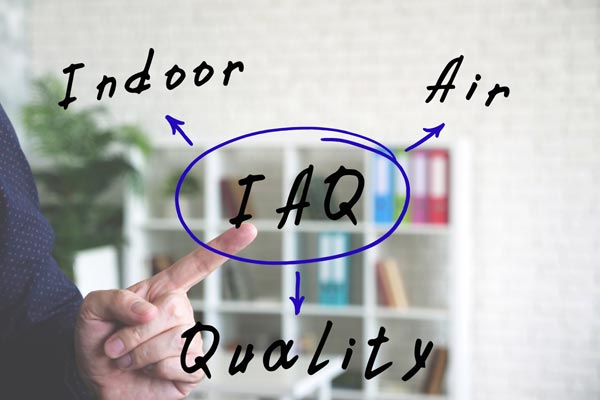Your Indoor Air Quality Guide

The Homeowners Indoor Air Quality Guide
It feels good around here! Spring has come, and the cold of winter is in the rearview mirror. After being cooped up inside, we can step out and take a breath of fresh spring air.
There is more truth to this than you know. According to the American Lung Association, indoor air maybe 2 to 5 times as polluted as outdoor air. Since the typical American spends 90% of the time indoors, indoor air quality has a significant impact on respiratory health.1
Sources of Indoor Pollutants
Where is all this bad air coming from? Major sources include:
- Plant life. Seasonal pollen and mold spores are often very evident in the spring and summer months; it is common to see lawn furniture and vehicles coated with a thin yellow layer of pollen.
- Animal life. Dust and dander are primarily made up of human and pet skin or hair particles. They can be particularly dangerous since they often feed microscopic insects called dust mites. These mites often trigger very strong allergic reactions.
- Manufacturing off-gases. Many manufactured items, including flooring and surface covers—paints and stains—release organic gas compounds. This is the source of that “new” smell. The gas continues to be released for years, although it is more noticeable in the first months.
- Whether from traffic or localized manufacturing, these gases can be extremely dangerous in large quantities.
The Part Outdoor Air Plays
Statistically, indoor air will largely reflect outdoor air. It is possible to scrub the air, but the common contaminants outdoors will find their way inside. There are a couple of factors that make an impact on indoor air.
- Outdoor air is very seasonal. There are three common sources of pollen: trees, wildflowers, and grasses. Different plants reproduce at various times of the year; the presence of pollen follows this cycle. Different pollens trigger allergic reactions in different people.
- Outdoor moisture promotes mold blooms. While mold spores might be present year-round, wet weather or standing water might stimulate the reproduction of molds and other fungi.
- Prevailing wind changes. If the wind direction changes with the season—west/northwest in the winter and south during the summer months—it can blow pollutants from distant places. This is very noticeable when the wind brings smoke from a distant wildfire.
Infiltration
Infiltration is a code word for leaks. During seasons of extreme temperatures, leaks may make your home drafty. On the other hand, it allows fresh air inside.
- Cracks and gaps are a minor source of outdoor air pollutants since some air passes through insulation that acts as a mini air filter. More air changes happen every time a door or window opens and closes.
- Opening a window on days with mild temperatures can dilute any buildup of indoor air pollution, especially the gases from manufactured products.
- The problems that arise from seasonal pollen and the concentration of indoor air pollution must be balanced for the best results.
Cleaning Indoor Air
Most homes have built-in methods of cleaning that significantly improve indoor air quality.
- Regular house cleaning tasks remove many common pollutants. Most of them are heavier than air, so when the air is still, they will fall to surfaces below. We commonly call the collection “dust.” Whenever a home is dusted, mopped, and vacuumed, most of the accumulated pollutants are removed.
- When the pollutants are airborne and moving, they are sucked into the HVAC system, and many more are collected on the air filter. Remember to change the filter at least once every three months to keep indoor air clean.
- Further cleaning of the HVAC happens when you call for annual maintenance and have your ductwork cleaned.
- If additional steps are needed because of a family member’s respiratory problems, connect with your factory-trained Trane technician for auxiliary equipment for additional air purification.
Indoor Air Quality
HVAC System Upgrades are a great way to increase the value of your home. Specific training and equipment are required to maintain modern AC systems. To find a local Trane HVAC maintenance technician, visit our Local Dealer search tool.
1 https://www.lung.org/clean-air/indoor-air#:~:text=Indoor%20air%20can%20be%202,and%20other%20underlying%20health%20conditions